Here is some useful information and hints to help you complete the Ontario Ministry of Labour, Immigration, Training and Skills Development’s online Worker Health and Safety Awareness in 4 Steps training session. Click on each section to learn more.
- What is Worker Health and Safety Awareness in 4 Steps?
- “Get On Board” Module – Hints
- “Get In The Know” Module – Hints
- “Get Involved Module – Hints
- “Get More Help” Module – Hints
- Certificate of Completion
- Workplace Health and Safety Training Courses
For more information about workplace health and safety and about safety training, contact ACUTE now.
Disclaimer: Information received and sourced July 26, 2017. This is NOT the Ontario Ministry of Labour, Immigration, Training and Skills Development’s Worker Health and Safety Awareness in 4 Steps training session. This is NOT a replacement for training. This page’s purpose is to provide hints and helpful practice to participants and workers in order to help reinforce workplace safety knowledge.
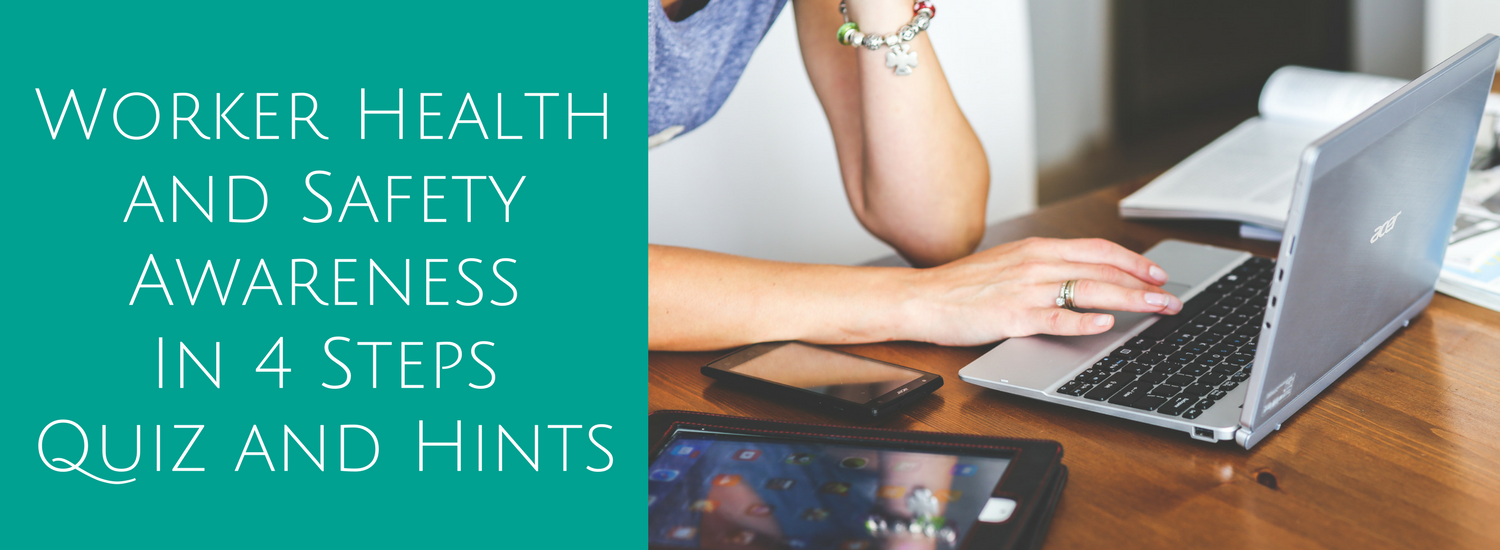
What is Worker Health and Safety Awareness in 4 Steps?
Worker Health and Safety Awareness in 4 Steps is a workplace safety training video and quiz that many workers in Ontario must complete before beginning their job. There are four parts, or modules, to the safety training:
This online training session and quiz help workers understand their rights and responsibilities at work. It outlines what an employer’s responsibilities are and everyday tips and facts about workplace safety. The training includes interactive quizzes, reading segments, and video segments.

Remember, while participating in the Worker Health and Safety Awareness in 4 Steps training, watch the entire video for each section before moving on to the questions.
Question – Who is more likely to get hurt on the job? New and Young? Or Experience?
Hint – People who begin new jobs are three times more likely to experience an injury at work during their first month on the job.
Question – Who has the most duties at work?
Hint – Everyone has responsibilities at work! However, the more people a worker is responsible for, the more responsibilities they have themselves. The person in charge of everyone else has the most responsibilities at work.
Question – True or False: Your employer or supervisor asks you to do something you do not know much about. Your employer or supervisor should “take every precaution reasonable in the circumstances for your protection?”
Hint – Remember that employers have the most responsibility at work and are responsible for their worker’s safety.
Question – “The Thousands of people in Ontario who suffer from work-related illness or injury each year might include your neighbours, family, or loved ones.”
Hint – Remember that anyone can get injured at work. Although new and young workers are more likely, accidents can happen to anyone.

New and young workers are more likely to get hurt on the job
Question – “New workers are less likely to get hurt on the job than people who have been on the job longer.”
Hint – Keep the statistic from above in mind – new workers are three times more likely to experience an injury at work during their first month on the job.
Question – “The Occupational Health and Safety Act and Regulations tell everyone from the employer to the newest worker how to make the workplace safe.”
Hint – Everyone has both rights and responsibilities at work, including responsibilities about making and keeping the workplace safe for everyone. This is outlined in the OHSA.
Question – “The OHSA puts the greatest responsibility on your employer to make sure no one gets hurt or sick on the job.”
Hint – Remember that employers are in charge of the most people in the workplace and therefore have the most responsibility.
Question – “It is against the law to fire or punish me for doing what the OHSA says.”
Hint – Workers are protected in the OHSA. This even includes the right to refuse unsafe work, and employers cannot fire a worker for refusing unsafe work.

Question – Which of the following are workplace hazards?
Hint – There are many types of hazards in the workplace, not just the obvious ones such as chemical spills or fall hazards. Something as seemingly innocent as a sudden loud noise can be a hazard.
Question – What health and safety questions should you ask your supervisor?
Hint – Fully understanding the hazards of your job as well as your rights and responsibilities is important – you can ask all of the listed questions!
Question – “The Occupational Health and Safety Act says you have the right to know about hazards in your workplace.”
Hint – Workers have the right to know, and employers and supervisors have the responsibility to tell workers about potential hazards in the workplace.
Question – “If hazards can make you sick, you will always start to feel sick right away.”
Hint – Some hazards are in fact fast-acting and can injure or make you feel sick right away. However, remember that not all hazards are the same. Some can take months or even years to make someone sick.

Certain hazards can make you feel sick right away
Question – “To keep from getting hurt on the job, you need to find out about the hazards while you’re working.”
Hint – Knowing about the hazards while you work is important, but should you really wait to find out about hazards? Remember, employers and supervisors must let you know about hazards and you must be trained before you begin work.
Question – “If you have any doubts about the safety of the work you’re doing, you should keep those doubts to yourself.”
Hint – Do you remember the questions from the beginning of the module? You are not only allowed but encouraged to ask your supervisor any and all questions you have about health and safety in the workplace.
Question – “If you see a hazard while you’re working, you should report it to your supervisor or employer right away.”
Hint – You have responsibilities at work as well, not just your supervisor or employer. Reporting a hazard immediately will help keep you and everyone else at your workplace safe.

Question – The three ways you can participate in keeping the workplace safe: are they true or false?
Hint – The OHSA gives workers the right to participate! There are many ways you can get involved and participate in keeping your workplace safe.
Question – Which of the following items should you ask yourself at the workplace to ensure everyone’s safety?
Hint – Proper training, understanding physical limits, being aware of where other workers are and if the task could harm them, knowing how to report hazards, understanding if there are any chemicals that can make you or others sick are all important questions to ask yourself.
Question – “It’s important that you know the safe way to do your job. You should share what you know. If you see a hazard, you must report it to your supervisor or employer.”
Hint – Following the OHSA guidelines and rules, knowing your rights and responsibilities, and understanding that telling your supervisor or employer about a possible hazard could save lives are all important information to know.
Question – “You should get involved in health and safety by asking questions, and you should put what you learn from training into practice on the job.”
Hint – Asking questions when you are unsure and putting training into practice are two great ways to stay safe on the job.
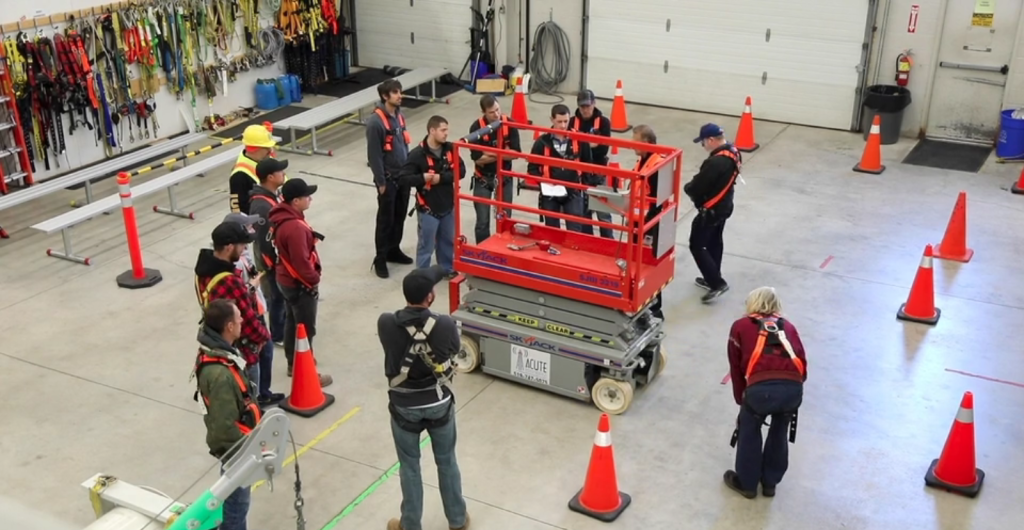
Use the safety techniques you learn in training on the job
Question – “If you can’t find any health and safety information posted in your workplace, you should just go back and not worry about it.”
Hint – Did you know that workplaces are required to post health and safety information in your workplace? Workers have the right to accessible workplace health and safety posters and information.
Question – “Your health and safety representative or joint health and safety committee can help you with any concerns that you might have about working safety.”
Hint – Health and safety representatives and joint health and safety committees are here to help you, and would be happy to answer any questions or address concerns that you may have.
Question – “It’s OK to take safety shortcuts to get the work done faster and on time.”
Hint – Cutting corners and taking shortcuts might at first seem like an efficient way to work, especially if you are experienced! However, it’s important to set a good example and not allow yourself to take the easy way in place of the safe way.

Hint for matching exercises – Pay close attention to the information about each organization.
Question – “If you report a hazard to your employer, supervisor, and/or your health and safety representative and they can’t find a way to fix it, you can call the Ministry of Labour, Immigration, Training and Skills Development’s toll-free number.”
Hint – Did you know the MLITSD has a toll-free number? It’s 1-877-202-0008.
Question – “If you have reason to believe the equipment you are using might hurt you or someone you work with, you have the legal right to refuse work.”
Hint – The OHSA outlines the many responsibilities and rights of workers. Workers have many rights, and that includes the right to refuse work.
Question – “Some workers, such as nurses, firefighters, and police officers, have a limited right to refuse work.”
Hint – Some occupations do have a limited right to refuse work.
Question – “It’s against the law for your employer or your supervisor to fire or punish you for doing what the OHSA expects you to do, or for asking them to do what the OHSA expects them to do.”
Hint – Remember that workers and employers must follow the OHSA, and as a worker, you are allowed to ask your employer to follow OHSA guidelines and expectations.

You are allowed to ask your employer to follow OHSA guidelines
Certificate of Completion
When you complete the Worker Health and Safety Awareness In 4 Steps training session, you will then be given the opportunity to fill in your name and e-mail address.
A certificate of completion will be given to you and sent to your email.
When you receive your certificate of completion, you will likely have to provide your supervisor or employer with a copy.
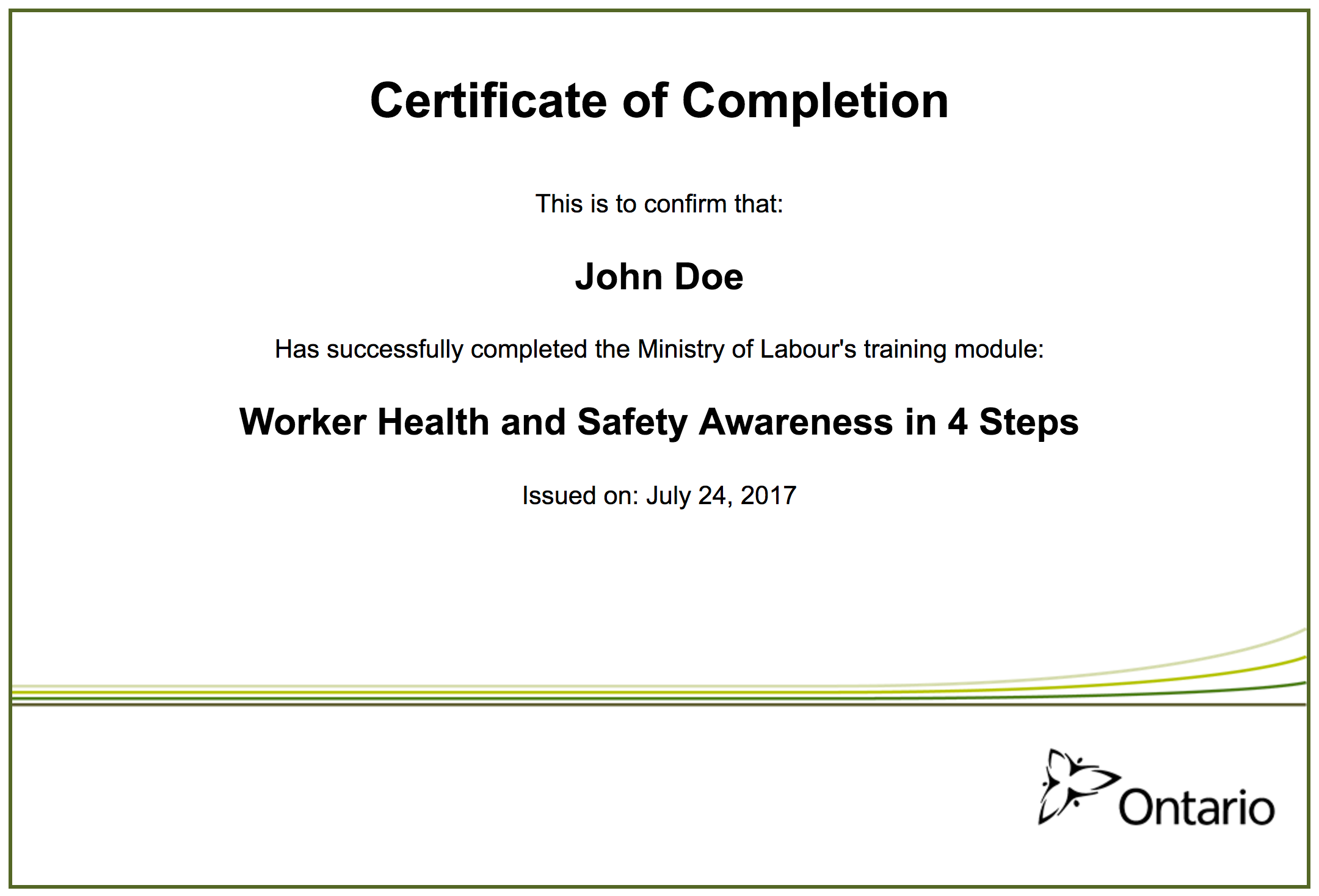
Workplace Health and Safety Training Courses
There are many different types of workplace health and safety training courses. Only some are legislated but they are very beneficial to take. Here are some of the more common workplace safety training courses. For a complete list of our courses, click here.
Working At Heights
ACUTE’s Working at Heights training program has been approved by the Chief Prevention Officer under the Ministry of Labour, Immigration, Training and Skills Development’s Working at Heights Training Program Standard and the Working at Heights Training Provider Standard. The ACUTE Working at Heights training provides theory and hands-on practical training and evaluation facilitated by highly skilled and competent instructors.
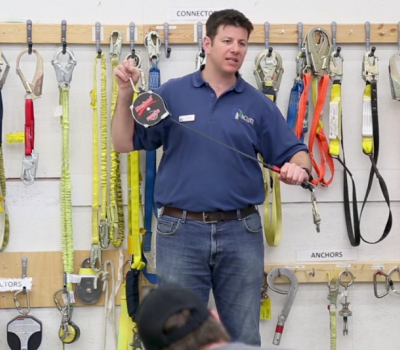
Part 1 Certification Basic Training for Joint Health and Safety Committee Members
This certification involves training in health and safety law, as well as the identification, assessment, and control of hazards. Standards for this training are set by the Ministry of Labour, Immigration, Training and Skills Development and the ministry also certifies JHSC members who complete approved training programs.

Confined Space Entry Awareness
This training program will familiarize a participant with the requirements of Ontario Regulation 632/05 – Confined Spaces. Furthermore, the training program is intended to provide entrants, attendants and competent persons with the skills and training required to recognize confined space entry risks and how to establish measured and corresponding controls. Participants will have the opportunity to become familiar with, inspect and use Confined Space Entry (CSE) access equipment and air quality instrumentation.

Confined Space Rescue
This training program builds on the content of the Confined Space Entry Awareness course to train participants on the safety considerations and how to safely perform rescues from confined spaces. This program has a very significant practical component that can be physically demanding for some. Participants will have the opportunity to extricate weighted mannequins from our confined space simulators.
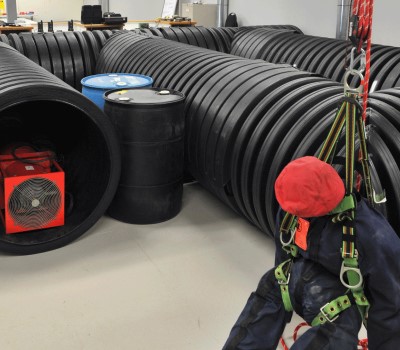
Elevating Work Platforms
Elevating Work Platforms (EWPs) such as scissor lifts and boom lifts can be safe solutions to working at height challenges. Unfortunately, lack of training, improper use and defective equipment has led to serious incidents involving workers in Ontario. The EWP course has been constructed to prepare operators for the safe use of EWPs. The theory module covers all classes of EWPs, while the practical module covers only the type of EWP used in the participant`s workplace.

40 Hour HAZWOPER
This training program covers the requirements of the OSHA HAZWOPER standard (29CFR 1910.120). This standard sets out the minimum training requirements for site workers on hazardous waste sites, environmental remediation and emergency projects in the United States of America. The quality and comprehensive nature of this standard make it applicable and attractive to those employers and workers who work at Canadian workplaces that contain environmental contamination or hazardous materials.
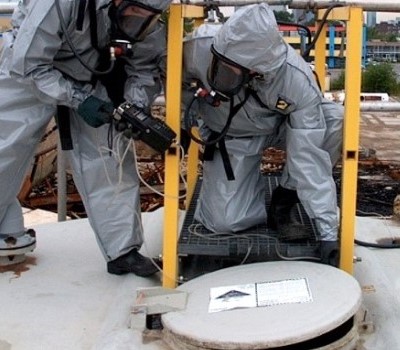
ACUTE – Ensuring Quality Training and Education
Some workplaces require more than online training sessions for their workers. The best way to keep everyone safe at work is by getting the best hands-on training for employees and ensuring that your trainer helps to build excellent team skills. ACUTE does more than help you comply with laws. Here are some ways that ACUTE goes beyond government compliance in Ontario health and safety training.
- Open Door Instructor-Student Partnership: ACUTE’s training services emphasize client participation. Staff foster relationships with clients and serve as a touchstone for advice moving forward.
- Serving Your Team and Industry: With a vast array of clients in the manufacturing, construction, health, academic, and government sectors, ACUTE brings the best safety practices from across the spectrum to your workplace.
- 100 Years Combined Experience: ACUTE provides comprehensive health and safety training, on-site safety services, and consulting services. With over 100 years of combined experience, our staff offers more than theoretical or abstract ideas. ACUTE offers solutions.
- Track Record of Success: ACUTE is rated 4.9/5 stars on Google reviews, demonstrating a commitment to our clients, quality, and a passion for training.
Contact us today for quality training in your workplace or on-site at ACUTE’s proven training facilities!
Ready to learn more about workplace safety and training?


